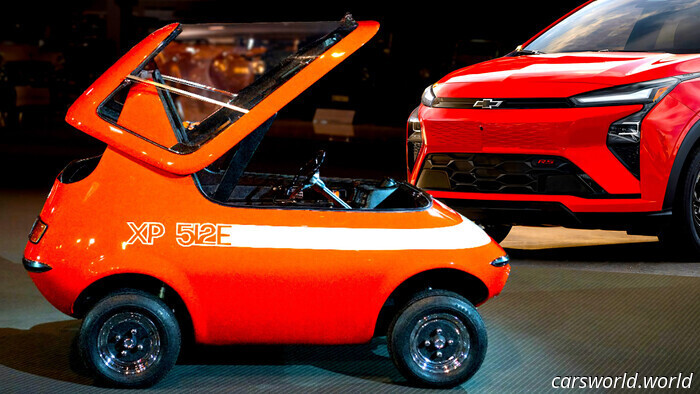
Long before the Chevy Bolt, GM created an electric vehicle resembling an egg on wheels | Carscoops
The 1969 512 Electric Experimental highlighted GM’s long-standing interest in electric vehicles.
Measuring just 86 inches in length, this fiberglass microcar was powered by an 84-volt battery. A full household charge took seven hours and provided a range of 58 miles.
In 1969, the automotive landscape was marked by stark contrasts. Two concept cars sharing the 512 name, yet created in different parts of the world, were challenging conventional notions of “experimental.”
One was the Ferrari 512 S Berlinetta Speciale, a V12 supercar that predated the Lamborghini Countach concept by two years, showcasing a design that seemed ready to break the sound barrier. In contrast, GM's small orange electric vehicle struggled to maintain the speed limit near schools.
Related: GM Secretly Plans A Lineup Of Affordable EVs Following The New Bolt
We previously examined GM’s 512 Electric Experimental, and given the recent advancements in the EV market, it's a fitting time to revisit this unique model, especially with the new Chevy Bolt slated for 2027.
How Compact Is Compact?
Designed primarily for urban transportation and part of a larger family of experimental GM microcars unveiled at the Transpo ’72 show—which featured various electric, gasoline, and hybrid options—the 512E was incredibly compact, as evidenced in these images.
At just 86.3 inches (2,190 mm) in length and 56 inches (1,420 mm) in width, it was a remarkable foot (300 mm) shorter and 3 inches (75 mm) narrower than an original Smart ForTwo.
Accessing its two seats involved a unique combination of a lift-up canopy that resembled a helmet with its visor up, along with a side-hinged front door, reminiscent of specialized bathtubs for seniors.
The small wheels are tucked into each corner, sporting wide tires akin to those found on tuned Minis in 1969.
The wraparound canopy likely provided excellent visibility, although even with substantial A-pillars, drivers would have ample opportunity to look around them.
Slow Yet Steady Performance
With a top speed of only 30 mph and a 12-second time to reach it, these statistics might seem unimpressive until you consider that the modern Citroen Ami, embodying a similar concept, is also limited to a comparable speed (28 mph / 45 km/h).
Moreover, Citroen claims a range of 47 miles, which the 512E exceeds by 11 miles (though measured differently), but the Ami can be fully charged in four hours, significantly less than the seven hours required for the GM microcar.
The most significant difference lies in the battery technologies. Unlike modern EVs, which utilize lithium-ion batteries, the 512E depended on traditional lead-acid batteries from Delco-Remy.
Despite its fiberglass body, the GM vehicle weighed only 1,250 lbs (567 kg), though the Ami is even lighter at 1,065 lbs (483 kg).
Although the 512E project did not lead to small EVs in Chevy showrooms during the 1970s and 1980s, GM’s subsequent unveiling of the Impact EV concept—and its production as the EV1 six years later—demonstrated that the company had not abandoned the idea of compact electric vehicles.
Now, half a century later, GM continues to pursue this market with the upcoming 2027 Bolt, prompting curiosity about how much more enjoyable it might be with a flip-up canopy and a touch of that optimistic 1970s spirit.




Other articles
 Even Rolls-Royce Is Now Offering EV Discounts As If It Were A Kia | Carscoops
The high-end car manufacturer provides a lease credit for its $422,000 electric vehicle, but it is unlikely to make a significant difference for its affluent customers.
Even Rolls-Royce Is Now Offering EV Discounts As If It Were A Kia | Carscoops
The high-end car manufacturer provides a lease credit for its $422,000 electric vehicle, but it is unlikely to make a significant difference for its affluent customers.
 Individual Paid New Porsche 911 Price for a 1992 Mustang Still Encased in Plastic | Carscoops
This 1992 Mustang originally had a sticker price of $16,274, but years later it was sold for significantly more than that amount.
Individual Paid New Porsche 911 Price for a 1992 Mustang Still Encased in Plastic | Carscoops
This 1992 Mustang originally had a sticker price of $16,274, but years later it was sold for significantly more than that amount.
 Everyone is purchasing pickup trucks, yet very few are actually using them as intended. | Carscoops
Trucks offer the assurance of strength and functionality, yet numerous owners operate them like regular cars.
Everyone is purchasing pickup trucks, yet very few are actually using them as intended. | Carscoops
Trucks offer the assurance of strength and functionality, yet numerous owners operate them like regular cars.
 Bentley Redefines Its Future with the New Flying Spur Sedan That Defies Expectations | Carscoops
The upcoming Flying Spur may transform the concept of luxury as the brand postpones complete electrification and reevaluates the integration of technology with tradition in its flagship sedan.
Bentley Redefines Its Future with the New Flying Spur Sedan That Defies Expectations | Carscoops
The upcoming Flying Spur may transform the concept of luxury as the brand postpones complete electrification and reevaluates the integration of technology with tradition in its flagship sedan.
 New Zeekr X Has Me Rethinking My Affections for Volvo | Review | Carscoops
The Zeekr X appears to be more roomy, more comfortable, and more upscale compared to the associated Volvo EX30, yet it comes at a lower price.
New Zeekr X Has Me Rethinking My Affections for Volvo | Review | Carscoops
The Zeekr X appears to be more roomy, more comfortable, and more upscale compared to the associated Volvo EX30, yet it comes at a lower price.
Long before the Chevy Bolt, GM created an electric vehicle resembling an egg on wheels | Carscoops
The 1969 Tiny 512 Electric Experimental concept featured a flip-up canopy roof, but it had a limited range of just 58 miles.
